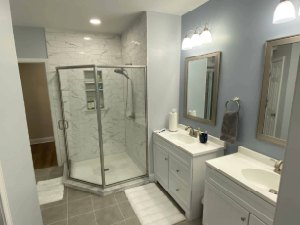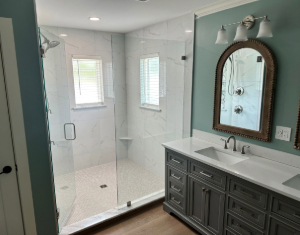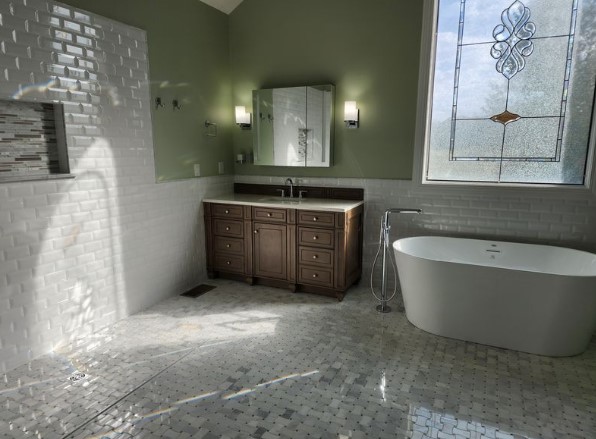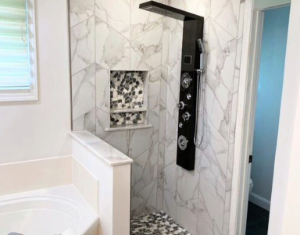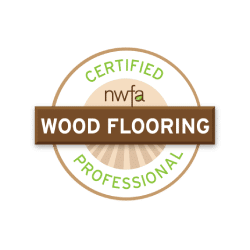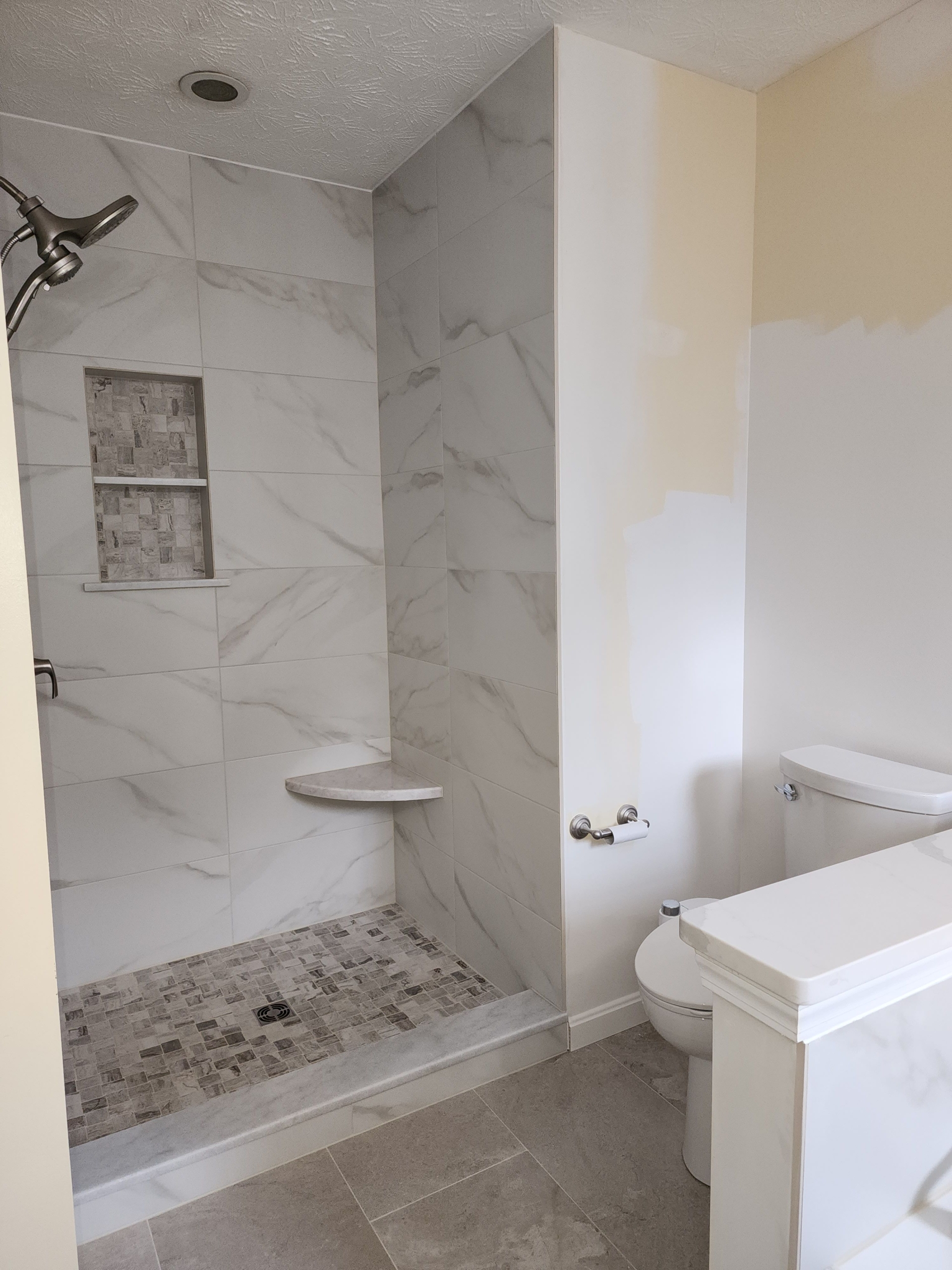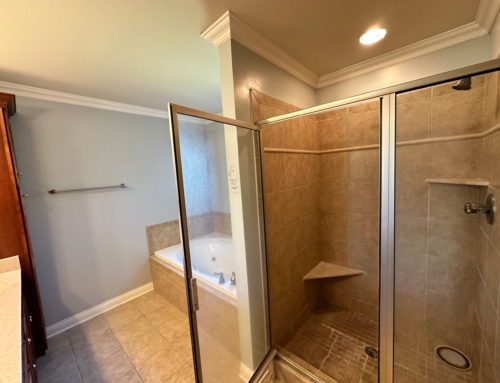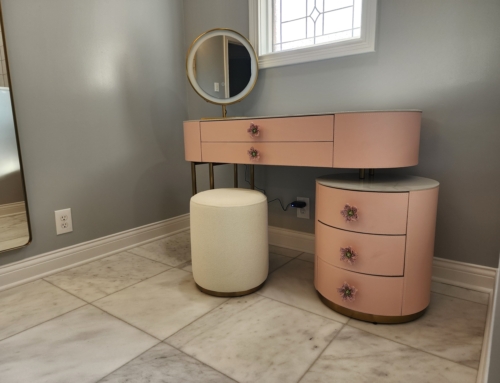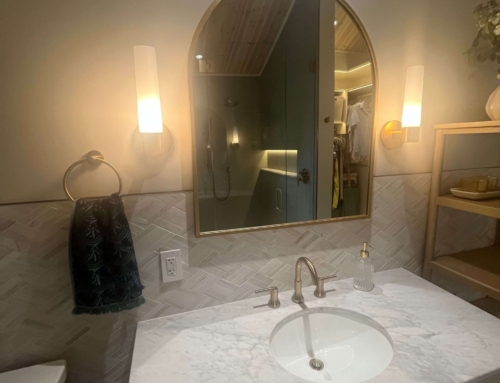When it comes to bathroom tile design ideas, the choices of what to tile, what type of tile to use, and the pattern of the tile all play a big role in both the form and function of your new bathroom. Whether you want to make your bathroom like a luxury spa, or create a personal oasis, the right tile choices can transform your bathroom into anything that you desire. Keep reading tol explore various choices for bathroom tile, including the areas to tile, types of tiles, and tile laying patterns.
Areas to Tile in a Bathroom
Floors
The most common area for tiling, bathroom floors require durable, slip resistant tiles.
Walls
Wall tiles create a seamless, cohesive look when floors and showers match them. Wall tile protects against moisture, and adds visual interest. You can tile all walls, create a feature wall, or an accent piece for a striking effect.
Shower Enclosures
Tiling shower walls and floors is essential to waterproof and creates a seamless, luxurious look.
Bathtub Surrounds
Tiling around a bathtub protects the walls and is an elegant choice for a bathroom tile design idea.
Backsplashes
A tiled backsplash behind the sink or vanity area protects the wall and adds an accent above the vanity and sink.
Accent strips
Narrow bands of decorative tiles can add visual interest and break up large expanses of plain tiles.
Niches and Shelves
Built in shower niches or open shelves can be tiled to match or contrast with surrounding tiles, creating functional and attractive storage spaces.
Ceiling
Tiling a bathroom ceiling is uncommon, especially in the shower area, but this unique feature creates a striking visual effect and provides additional protection against moisture.
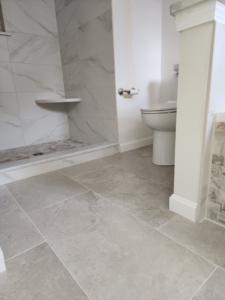
Types of Bathroom Tiles
Ceramic Tiles
Affordable, durable, and available in a wide range of colors and designs. Ceramic tiles are a great tile design idea because they are easy to clean and maintain. The most popular choice for bathroom floors and walls.
Porcelain Tiles
Denser and less porous than ceramic, porcelain tiles are even more durable. They come in various finishes, including those that mimic natural stone.
Natural Stone Tiles
Options like marble, granite, slate, and travertine offer unique patterns and textures. They’re gorgeous, but require more maintenance and regular sealing.
Glass Tiles
These tiles add reflection and lumination to bathrooms. Glass is often used for accent strips, backsplashes, or feature walls.
Mosaic Tiles
Mosaics are small tiles arranged in patterns. They’re perfect for creating intricate designs, adding texture to a shower floor, or used as an accent piece.
Large Format Tiles
Oversized tiles can make a small bathroom appear larger and create a sleek, modern look with fewer grout lines. However, grout provides slip resistance.
Subway Tiles
Classic rectangular tiles that offer a timeless look. They can be laid in many different patterns.
Pebble Tiles
Small and round, these tiles add a natural, spa feel to bathroom floors or shower floors.
Metallic Tiles
Tiles with metallic finishes can add glamor and reflect light. They make a bathroom feel larger and more luxurious.
Textured Tiles
Tiles with raised patterns or 3D effects can add depth and interest to bathroom walls, or slip resistance to a shower floor.
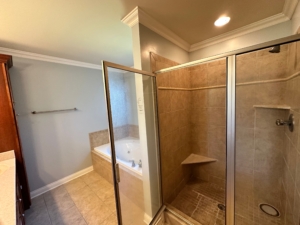
Tile Laying Patterns
The way tile is laid impacts the look of a bathroom in a huge way. Here are some popular laying patterns:
Grid Pattern
The most straightforward layout. Tiles are aligned in straight lines both vertically and horizontally. This is the typical pattern for square tiles and creates a clean, orderly look.
Brick or Running Bond
Tiles are staggered, similar to how bricks are laid. This pattern is popular for rectangular tiles, such as subway tiles, and can make walls appear wider.
Herringbone
Tiles are laid at 45-degree angles to each other, creating a V-shaped pattern. This dynamic layout adds visual interest and can make a space appear larger.
Basketweave
Rectangular tiles are arranged to look like interwoven strips, creating a textured, three dimensional effect.
Diagonal
Square tiles are rotated 45 degrees to create a diamond effect. This pattern can make a small space feel larger but may result in more tile waste due to cuts.
Chevron
Similar to herringbone, but the ends of the tiles are cut at an angle to create a zigzag pattern.
Hexagon
Hexagonal tiles create a honeycomb effect that adds visual interest.
Windmill
A combination of large square tiles with smaller square tiles in the corners. They pattern resembles a pinwheel.
Vertical Stack Bond
Rectangular tiles are stacked vertically in columns. This tile pattern is popular in modern tile design ideas.
Fish Scale or Fan Pattern
Tiles with curved edges are laid to resemble fish scales or fans to create a soft, flowing effect.
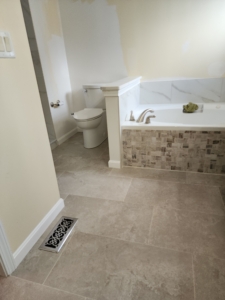
Combining Tile Types and Patterns
For a truly unique bathroom design, consider combining different tile types, sizes, and patterns in your tile design ideas:
Mix and match
Use different tiles for different areas. Create feature areas with contrasting tiles. If you choose a neutral tile, consider adding bold accent tiles here and there.
Create zones
Use distinct tile patterns or colors to define different areas within the bathroom, such as the shower or vanity.
Mosaic Accents
Use mosaic tiles to create borders, backsplashes, or feature walls that compliment larger tiles.
Play With Scale
Combine large format tiles with smaller accent tiles to add visual interest and break up monotonous design.
Grout
Choose contrasting grout colors to highlight tile patterns or use matching grout for a more seamless look.
Practical Considerations
When selecting bathroom tiles, there are some things to keep in mind:
Slip Resistance
Ensure floor tiles have sufficient texture or grip to prevent slips and falls. Smaller tiles with more grout lines, such as mosaic tiles, provide better traction.
Maintenance
Consider the cleaning and maintenance requirements of different types of tile.
Durability
If you’re thinking long term, porcelain tiles are often worth the investment over typical ceramic.
Budget
Balance your design with your budget. Consider the material costs as well as the cost of labor.
Lighting
Consider how your tile choices will interact with your bathroom lighting.
The takeaway is that bathroom tile design offers endless possibilities for creativity and personalization. By carefully considering the areas to tile, types of tiles, and laying patterns, you can create a bathroom that is functional, and a reflection of your personal style. Whether you prefer a classic, timeless look or a bold, contemporary design, the right combination of tiles can turn your bathroom into a beautiful and inviting space that you’ll enjoy for years to come.
The Flooring Masters team is happy to help you explore your bathroom tile design ideas. Please Call or Email us today for a free estimate.

